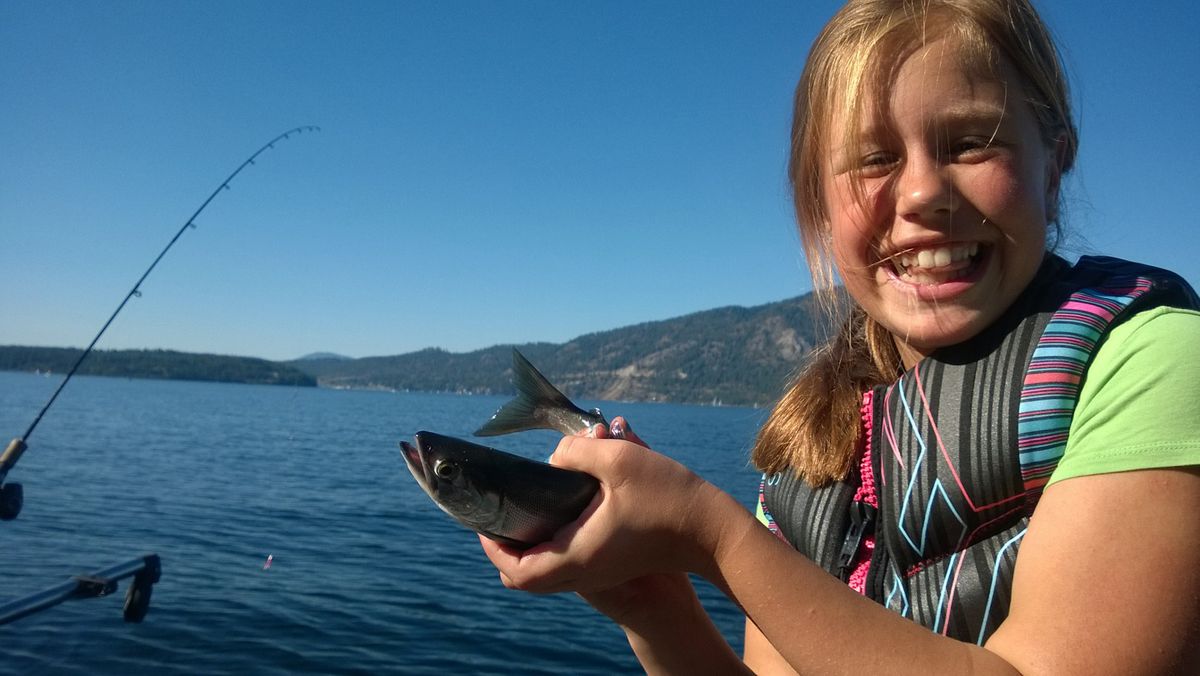Landers: Pend Oreille kokanee top ‘State of Lake’ review

Anglers responded with hooks, lines and the best success rates in decades to the recovery of kokanee in Lake Pend Oreille last year.
The Idaho Fish and Game Department says anglers harvested nearly 150,000 kokanee from the lake in 2014, buoyed by the state raising the kokanee daily bag limit last spring from six to 15 fish.
“While that’s a lot of fish, it was still only a fraction of the total adult population,” said Jim Fredericks, department regional fisheries manager. “IDFG surveys indicated a population of 1.4 million adult kokanee, which is one of the highest estimates since the 1970s.”
Lake trout predation has been the primary factor limiting kokanee recovery for well more than a decade, Fredericks said. The kokanee fishery was closed to angling in 2000 and wasn’t reopened until 2013.
Aggressive efforts to remove lake trout involved:
• Commercial netting, which dramatically reduced the size of the lake trout population and allowed a rapid expansion of the kokanee population.
• Angler Incentive Program, which paid anglers $15 for each lake trout head they turned in from the lake. (The bounty also included the lake’s prized rainbow trout until 2013, when kokanee were recovered enough to ease off on the rainbows, much to the approval of the lake’s trophy anglers.)
Andy Dux, the agency’s principal research biologist, said kokanee are poised to do well over the next few years.
“Juvenile kokanee were abundant, with fry and age-1 fish looking particularly strong,” he said. “Age-2 kokanee were less abundant than the previous two years, but still appear to be a reasonably strong age group when compared with historical estimates.”
Maintaining the kokanee fisheries still faces challenges, Dux said.
Predation by lake trout must continue to be addressed in a sustained effort. Water level management through Albeni Dam must be watched for its impacts on kokanee spawning.
“Improvements have been made in the timing of drawdowns and it appears at this time that kokanee have adequate spawning areas,” he said.
Mysis shrimp may pose the biggest future challenge to kokanee. Introduced in the late 1960s in a misguided plan to boost the size of the lake’s trophy trout, the tiny shrimp spread through the lake by the mid-’70s. Soon they were outcompeting kokanee for zooplankton, the staple food item for both the shrimp and the kokanee.
By coincidence, as far as researchers know, the mysis shrimp nearly collapsed around 2012 in a population decline that still isn’t fully understood. It likely was beneficial to kokanee recovery that was booming at the time, Dux said. But as the shrimp are naturally rebounding, what will their impact be? Will the lake have a lower carrying capacity for kokanee?
The situation gives researchers an unexpected opportunity to study the relationship.
Meanwhile, the trophy rainbow trout fishery has showed continued signs of improvement in 2014, Fredericks said.
“As kokanee density has increased in recent years, so have rainbow trout growth rates,” he said, noting that kokanee are a staple for big trout. “Anglers caught more trophy rainbow trout in 2014 than they have in a long time, including many fish over 20 pounds.”
In addition to an overview of the Pend Oreille fishery at the annual State of the Lake meeting on Feb. 19, state fisheries managers will explain how fishing regulations will be proposed for 2016 through 2018.
The State of the Lake event will be at the Ponderay Events Center by the Bonner Mall north of Sandpoint.
The department is inviting anglers to present proposals in several other ways, including calling the regional fisheries managers, going online or attending public open-house meetings.
Rule-change ideas that have generated discussion so far for Idaho fisheries include:
• Increasing fish possession limits to more than the daily bag limit. (Currently, it’s unlawful to have more than one daily limit in your possession until the angler is back to the final place of residence.)
• Eliminating the “unlimited rod rule” on Lake Pend Oreille.
• Additional restrictions on rainbow trout in Pend Oreille (currently six fish, only one more than 20 inches).
• Increasing kokanee limit on Spirit Lake (currently 15 fish “regional rule”).
• More restrictive largemouth bass rules on Hayden Lake to improve quality (currently year-round, two-fish limit with 16-inch minimum).
• Increase minimum size limit on chinook in Coeur d’Alene Lake (currently 20 inches).
Open house public meetings on fishing proposals include:
Feb. 17 –Coeur d’Alene, IFG Regional Office, 2885 W. Kathleen Ave., 8 a.m. to 5 p.m.
Feb. 26 – Moscow, Fairground Exhibit Building, 1021 Harold St., 6 p.m.
Fisheries managers don’t foresee any major rule changes this cycle, especially for Lake Pend Oreille, Fredericks said.
“The main topics related to Lake Pend Oreille would be whether to reconsider the ‘unlimited rod’ rule, which currently allows anglers to fish with multiple rods when fishing from a boat; and, whether or not to implement more restrictive rules on rainbow trout in order to improve the trophy fishery,” he said.
Formal proposals to fishing rules will be drawn up this summer for public review before being presented to the IDFG Commission, he said.
Contact Rich Landers at (509) 459-5508 or email richl@spokesman.com.